The 27-inch Apple iMac Review (2011)
by Anand Lal Shimpi on May 27, 2011 2:30 AM ESTPower, Thermals and Noise
I started this review complaining about how loud the 15-inch MacBook Pro gets, but with 32x the physical volume the 27-inch iMac is near silent. Even under load the system is very quiet, almost too quiet. Apple chose a very lax fan profile which results in some very high external temperatures. The iMac takes in cool air from the bottom of the display and exhausts it up top behind the display. Playing Half Life 2 Episode Two I measured a maximum surface temperature of 125F at the exhaust vent. Again, unless you're doing something weird with the iMac on your lap this isn't an issue. Keep in mind that the Sandy Bridge CPU in the 15-inch MacBook Pro carries a 45W TDP and what's in the iMac is either 65W or 95W. Add in a larger, hotter hard drive and potentially a beefier GPU and you have a recipe for a pretty warm machine.
| 2011 iMac Power Usage | ||||||
| 27-inch iMac (Mid 2011) | Idle | Cinebench R11.5 | Half Life 2 Episode Two | |||
| Minimum Brightness | 54.1W | 108.3W | 149.0W | |||
| 50% Brightness | 86.6W | 141.6W | 180.0W | |||
| 100% Brightness | 144.5W | 198.3W | 240.0W | |||
With a large integrated display power consumption obviously varies depending on brightness. At idle, power consumption ranges from 54W to 144W. Under load the range quickly gets ever higher. I measured max system power consumption at 240W running Half Life 2 Episode Two.
Power consumption isn't out of control but you've got a billion transistor CPU, a 1.7B transistor GPU and a high resolution 27-inch display + backlight - it's going to draw some power.
Performance
Having never previously been a fan of the iMac, I don't actually have any historical performance data to compare to. What I do have however are scores from Mac Pros and of course the MacBook/MacBook Pro lines from the past couple of years.
Adobe Photoshop CS4 Performance
The Retouch Artists Speed Test we use for our CPU testing under Windows also works under OS X. We're running the exact same benchmark here, basically performing a bunch of image manipulations and filters and timing the entire process.
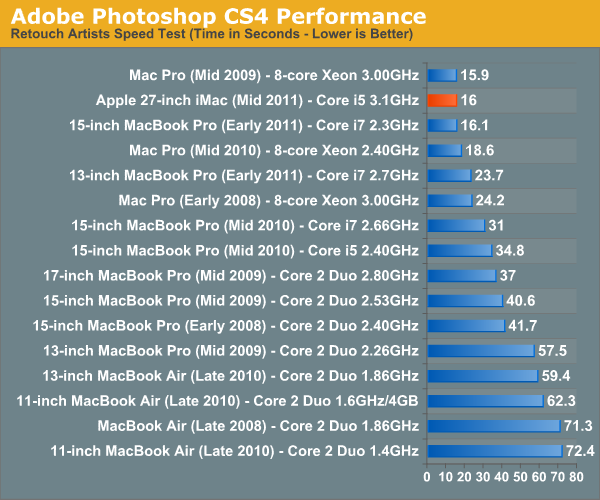
The high-end 27-inch iMac is a very capable Photoshop machine. A hair faster than the new MacBook Pro, the iMac delivers the same performance as an 8-core Mac Pro from 2009 or 2010.
Aperture 2 RAW Import
For my Aperture test I simply timed how long it took to import 203 12MP RAW images into the library.
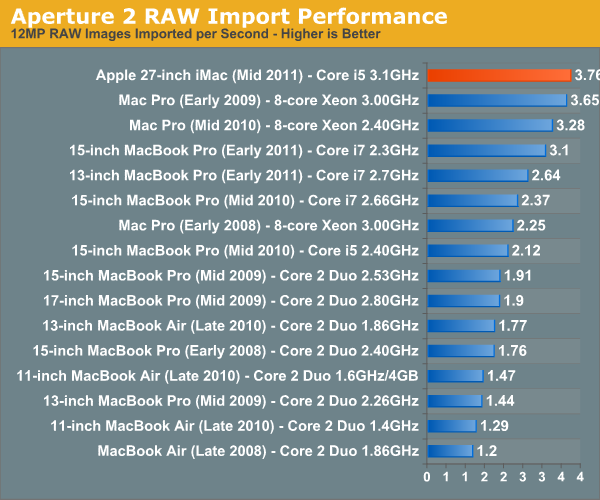
We have a new winner here! The MacBook Pros were always limited by their slower 2.5" hard drive, but the iMac with Sandy Bridge in additional to a speedier disk give us better image import performance than the '09 and '10 Mac Pros. I told you this thing was fast.
Cinebench R10 & 11.5
I’m a fan of the Cinebench tests because they lets me show off both single and multithreaded performance in the same workload. First, the single threaded performance:
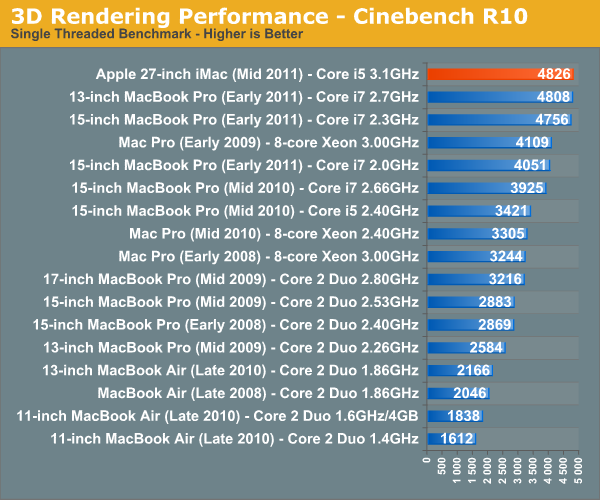
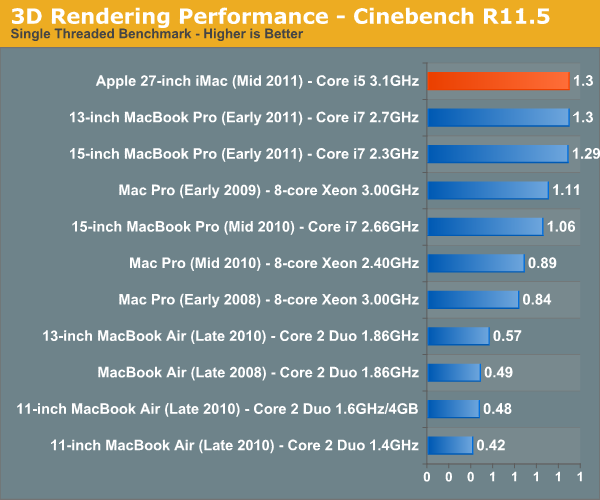
Sandy Bridge quad-core CPUs make no sacrifices. You get excellent single threaded performance which means general OS usage, launching applications and even rendering most web pages happens as fast as physically possible as the other cores are power gated and asleep. Start multitasking however and you'll see the Core i5 in this machine is no slouch:
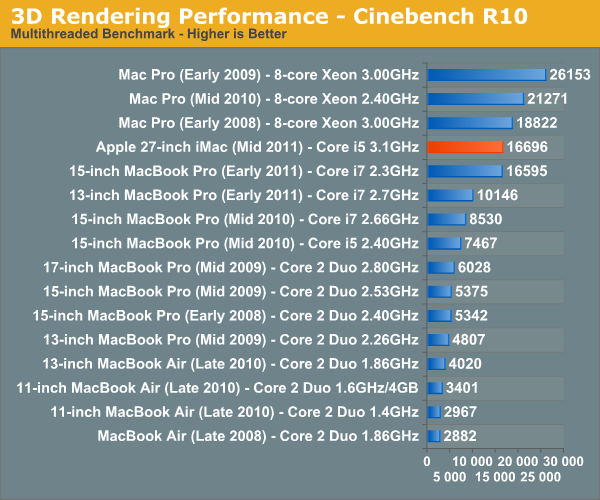
There's still no replacement for more cores when it comes to heavily threaded applications, the past three years of 8-core Mac Pros are still faster than the new 27-inch iMac here. I suspect the upgraded Core i7 would at least let the iMac beat the 2008 Mac Pro thanks to Hyper Threading, but the other two systems are simply out of reach. For those users, you're better off waiting for the Sandy Bridge-E Mac Pro update expected sometime in Q4.
You'll notice in Cinebench R10 the 15-inch MacBook Pro is nipping at the heels of the new iMac. Chalk that up to the larger L3 cache and Hyper Threading, both advantages enjoyed by the MacBook Pro. Look at what those advantages do in Cinebench R11.5's multithreaded test:
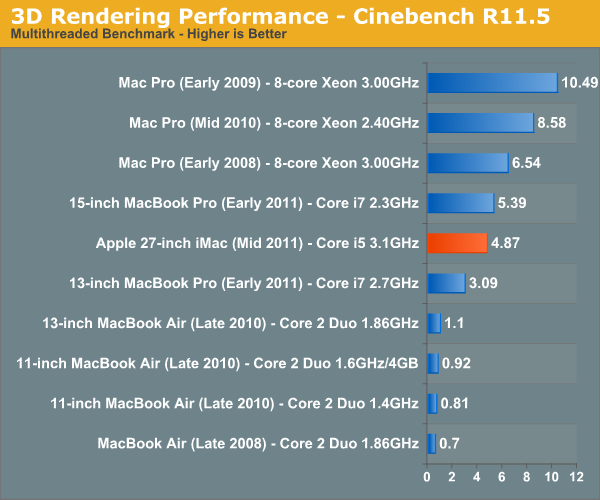
Here the MacBook Pro actually gains on the iMac. More threads and more cache are better suited for the Cinebench workload. If you do a lot of offline 3D rendering and you want the iMac, I'd suggest upgrading to the Core i7-2600 that Apple offers. You get a not insignificant boost in clock speed but more importantly, Intel switches on Hyper Threading which gives you twice as many threads.
Quicktime H.264 Video Encoding
Our final benchmark is more consumer focused. Here I'm taking an XviD and converting it to an iPhone-supported H.264 format.

QuickTime doesn't make tremendous use of all cores all of the time, and thus the MacBook Pro loses its threading advantage. The iMac is our new champion of this test.










139 Comments
View All Comments
smithj - Sunday, May 29, 2011 - link
People not within the European Union do not pay the VAT tax. If you live outside of the European Union, you pay £369.00 which is around $570 USD/AUD so he's completely correct.Even if you live in the European Union, you're going to be saving a similar amount since I imagine Apple products get the VAT tax slapped onto them as well. Doesn't change anything.
On the Hazro website:
"If you are ordering from outside the UK and EU, you will not be charged VAT."
There are extremely good reasons for getting a iMac but from a parts point of view its terrible value. You can't measure the benefits of the iMac however with just plain figures and specs.
Kristian Vättö - Sunday, May 29, 2011 - link
Ahh, that explains it then. I didn't look any further so didn't know about the international price. Customs may be added to the price though (not sure about the US policy as you don't VAT. If I buy something from the US, I will have to pay the Finnish 23% VAT before I can receive it).The Hazro looks very good though, thanks for linking it. Something to keep in mind when this oldish iMac needs to go. 500€ for a 27" 1440p display doesn't sound that bad, could get two of them for the price of one 27" ACD
repoman27 - Sunday, May 29, 2011 - link
I took issue with OWC's blog posts about the HDD upgrade issues in the 2011 iMac, and was hoping to find a better clarification here than the one in this review. OWC insisted on using the terms "standard", "leads" and "pins" in odd ways, and some of that seems to be echoed here.The HDD power cable in the iMac (Mid 2011) has 7 conductors, a standard 15-pin SATA power connector on one end, and a small 7-socket connector on the other which attaches to a header on the logic board. This assembly, while proprietary, is not necessarily any more so than the ones that ship with modular PSUs. It is more common to see SATA power cables with only 4 conductors (GND, 5 V, GND, 12 V) or 5 conductors if 3.3 V is also supplied. Several pins are then ganged together in the 15-pin connector to support the specified current requirements. As noted in the article, Apple is using relatively small conductors, and thus 2 are used in tandem for 12 V, they also elected to use the reserved pin 11 of the 15-pin SATA power connector for temperature monitoring. Pins 10 and 12 must both be connected to ground, although most of the time one conductor is used and pins 10-12 are all ganged together. Apple couldn't do this, so instead their 7 conductors are for GND, 5 V, GND, Temp, GND, 12 V, 12 V.
It is not common behavior for HDDs to output a temperature signal on pin 11 of the SATA power connector. While the model numbers and controller boards of the drives that ship in the 2011 iMacs look to be no different from retail ones, there would appear to be differences in the firmware that allow for this functionality. I would imagine that patching the firmware of a retail drive is possible.
If you ground pin 11 of the 15-pin SATA power connector, SMC will act as if there is no 3.5" drive installed. This means that the speed of the HDD fan will not increase above a certain baseline, and if you really do have a 3.5" drive in that bay, it will not properly dissipate the heat generated by it. If you use this trick to swap out the stock drive for an after-market one, you should also use S.M.A.R.T. based fan control software.
There are separate, clearly labeled power headers for HDD, ODD and SSD on the iMac's logic board. It is probably a better idea to use the dedicated SSD power header than a Y-splitter if you add a 2.5" drive to an iMac that didn't ship with one installed. The HDD cable was more than likely not designed to support two devices, and most Y-splitters for SATA power cables gang pins 10-12, thus grounding pin 11 and preventing the SMC from receiving HDD temperature data. The SSD power header on the 27-inch models is a standard 6-pin slimline SATA power connector, but on the 21-inch it is just a small 4-pin header.
The design of the iMac in general deters the casual from servicing their own hardware, and while some are discouraged by this, it's a ridiculous stance to take. Most people who purchase a new Mercedes S-Class don't worry about the fact that they probably won't be able to service it themselves (even if they are a fairly competent mechanic), or that it contains proprietary cable assemblies. If you don't feel comfortable servicing or modding your gear yourself, just take it to someone who does.
MadMinstrel - Sunday, May 29, 2011 - link
A 512MB <i>framebuffer</i>? Really? So that's all you think GPU memory is useful for? That might have been the case in the good old S3 ViRGE days, but right now it <i>really</i> doesn't work that way and I would expect someone writing for AnandTech to know that. In fact, GPU memory holds at least two framebuffers and sometimes as many as 6. More if you count all the intermediate rendering steps such as depth buffers, accumulation buffers, G-buffers, albedo buffers, etc, as used in modern deferred rendering engines. Textures, geometry, physics data, and sometimes even some of the game logic also go into GPU memory. Maybe I'm just being pedantic about this but I guess it really annoyed me because I actually <i>care</i> about Anand being accurate.Sunburn74 - Monday, May 30, 2011 - link
Not for me thanks. Too pricey and lousy specs. I also don't care about TN vs IPS panels. Most people don't care. Some enthusiasts do, but you can't really argue that iMacs are targeted for the average joe who don't know a ton about pcs and just wants it to work whilst arguing that the average joe can appreciate a 500 dollar difference between an IPS panel and TN panel. The truth is most people don't even know there are 2 types of panels floating about.I consider myself an enthusiast. I've spent a couple months working on a last gen 27inc iMac in the past as a reference point, with a lot of adobe studio stuff. Long story short, I wasn't impressed. I found the machine to be slow to average in terms of performance (compared to the HP tower workstations we had down the hall for "real work" haha). Throw out the nicer display (who's value is questionable depending on who you talk to. Again I've read in the comments how imacs are great for your dad and mom and your granny.Your granny is not noticing a difference between a 27inch HP tn panel and a 27inch mac IPS panel) and I don't really see what the iMac brings to the table that all the other all in ones don't have. I just don't really see a good target audience outside of mac enthusiasts who just gotta have it.
Its not great for people who need a pc that just works without hassle but are limited by budget (your mom, your dad, your granny, your girlfriend in college)
Its not great for the power users like myself who render and process in different ways thousands of high def images a day for scientific purposes. The HP workstation crushed the mac with its superior specs and apparently less aesthetic screen (a high end HP 30 inch TN panel).
Its not great for the true computer enthusiasts who likes to know whats in his pc and enjoys servicing his own box.
the iMac is truly like the mercedes benz and not in a good way. Mercedes make nice cars, but no one can disagree that those cars (just like the iMac) are
1)For the rich for whom cost is not truly an issue
2)for those who don't have an interest in servicing and maintaining their own cars and will have the dealer do it all,
3) For those who don't use their cars for actual work where the performance of the car actually matters (otherwise they'd go with the mac workstation or any othre workstation or build their own).
The imac just puzzles me and yet it sells so well apparently.
JFA - Tuesday, July 26, 2011 - link
It would be great to see comparison with previous generation of iMacs. Nowadays one can find quite a discounts on previous gen.javaporter - Tuesday, September 27, 2011 - link
I didn't read all 14 pages of comments, someone probably mentioned this, but you might want to look at dropbox. I have the 50GB option. It's enough for core project folders, my 1Password keychain, and various things I want to always have access to.I had the same issue as the author when deciding to leave a Mac Pro for a Macbook Pro. I did and worked that way for a while, however, recently I went back from a MBPro to an iMac and a Macbook Air.
With dropbox, I don't really have to worry about moving files anymore. It's still not perfect; I still have to worry about 2 machines to update software on and my photos won't fit on my MBAir of course (nor will iTunes), but for me, it's still worth it to have a desktop. I liked my MBPro, but it just never seemed to be as fast or easy as the desktop or as portable as the Air (I had the 17" — pretty unusable when flying coach).
timmillea - Monday, December 19, 2016 - link
So, five years later and this is still a very attractive machine. It is the last in the line of iMacs that do not need a 'pizza cutter' and replacing double-sided tape to obtain access to upgrade. Also the last with an optical drive which is still handy for ripping movies, music and sharing the same with people who are not riding the Apple wave. A 3.4 GHz quad-core i7 with a (ideally) 2GB GPU is still a very serious amount of computing power. Upgrade to 2 x SSDs with guides freely available on the net and configure them as Raid 0 and you have Mac-Pro challanging performance with a superb display in the size of the display alone available on the Bay for a third of the original price.Rendell001 - Sunday, July 29, 2018 - link
Thats very reassuring to know timmillea, I have the same model too which I picked up on eBay back in 2014 for £900. I love it for the same reasons you do though I've not tinkered with the insides yet. Needed to know if it would still hold up even now in 2018.